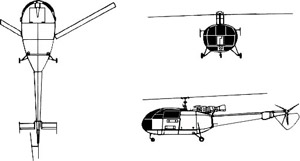SA315 Alouette II
Summary
| Category | Military Helicopters |
| Origin country | 🇫🇷 France |
| Manufacturer | Aérospatiale |
| First flight | 12 March 1955 |
| Year introduced | 1957 |
| Number produced | 1300 units |
Description
Although Sud-Est's previous helicopter design proved too complex, the French government sought a production helicopter within two years, stating that rotary wing activities would cease otherwise. SNCASE responded with seven turboshaft engine designs. Joseph Szydlowski of Turbomeca developed the Artouste, a single shaft turbine engine. The X.310G design was selected, paired with an improved Artouste engine, and fast-tracked into production as the SE 3130 Alouette II. On 12 March 1955, the prototype SE 3130 performed its maiden flight. In April 1956, the first production Alouette II was completed, making it the first production turbine-powered helicopter in the world. In 1964, the SA 3180 Alouette II Astazou was introduced, using the Turbomeca Astazou IIA engine in place of the Artouste II. Production of the Alouette II ended in 1975 after more than 1,300 had been built. The Aérospatiale SA 315B Lama had been developed for high-altitude operations to address that niche, and the Aérospatiale Alouette III also entered production.
The Aérospatiale Alouette II is a light helicopter powered by a single Turbomeca Artouste II turboshaft engine, producing a maximum of 400 hp. The design incorporates an automated fuel supply governor to control the main rotor speed, which removes the need for a twist-grip throttle and a conventional link between the throttle and the collective-pitch. The Alouette II uses a control lever arrangement to regulate collective-pitch and actuate the governor, applying power to conform with flight conditions automatically. The transmission is simplified by the absence of a clutch. Alternative landing gear configurations included skids, wheels, or pontoons. The cockpit featured a dome-shaped windscreen for enhanced visibility. The Alouette II could perform as a flying crane, with a 500-kilogram (1,100 lb) external underslung load.
For military applications, the Alouette II could be outfitted with a range of armaments. It was the first helicopter to be equipped with anti-tank munitions, specifically the SS.11 MCLOS wire-guided anti-tank missile. The French Army equipped their Alouette IIs with machine guns, while the French Navy configured theirs with aerial torpedoes for anti-submarine warfare.
Almost immediately upon entering service, French forces commenced combat operations using their Alouette II fleet during the Algerian War, where it proved a valuable asset. As a troop-transport, up to four fully equipped soldiers could be airlifted. Some Alouette IIs were modified and armed with Nord Aviation-built SS.10 or SS.11 anti-tank missiles. Rhodesia was a significant user of the Alouette II. Early operations were flown by the Army and British South Africa Police, including paramilitary and aerial reconnaissance operations. Throughout the 1960s, the type progressively spread into additional roles, including aerial supply, casualty evacuation, communications relays, and troop-transports. Rhodesian aerial operations typically involved flying under relatively high and hot conditions, which reduced the efficiency of aircraft; however, the Alouette II proved to be both hardy and relatively resistant to battle damage. To extend the range, fuel caches were strategically deployed across the country for refuelling purposes. The Rhodesian Security Forces developed the Fireforce tactic, rapidly encircling and enveloping enemies, for which the Alouette II served as a core component. The rotorcraft was also in use in over 80 countries, including 47 separate armed forces.
Main Variants:
-
SE 3130 Alouette II: The initial version, it was powered by a Turbomeca Artouste II series engine, rated at 300 kW (400 hp) for takeoff, and had a maximum weight of 1,500 kg (3,300 lb).
-
SE 313B Alouette II: An improved version of the SE 3130, it used a Turbomeca Artouste IIC5 or IIC6 engine, also rated at 300 kW (400 hp) for takeoff, but its maximum weight was increased to 1,600 kg (3,500 lb).
-
SA 3180 Alouette II Astazou: This version was powered by a Turbomeca Astazou IIA or IIA2 engine, which was more powerful but still limited to 300 kW (400 hp) by rotor transmission constraints, while maintaining a maximum weight of 1,500 kg (3,300 lb).
-
SA 318B Alouette II Astazou: An adaptation of the SA 3180, it featured an increase in the maximum weight to 1,600 kg (3,500 lb).
-
SA 315B Lama: Designed for high-altitude operations, it combined the Artouste powerplant and rotor system of the Alouette III with a reinforced Alouette II airframe.
Technical specifications
| Version: SE 313B Alouette II | |
|---|---|
| Height | 2.8 m (9.0 ft) |
| Length | 9.7 m (31.7 ft) |
| Service ceiling | 2,300 m (7,546 ft) |
| Empty weight | 895 kg (1,973 lbs) |
| Max. takeoff weight | 1,600 kg (3,527 lbs) |
| Climb rate | 4.2 m/s (13.8 ft/s) |
| Powerplant | 1 x turboprop Turbomeca Artouste IIC6 delivering 343 kW each |
Current operating countries
| Country | Units | ||
|---|---|---|---|

|
India | 60 (+2) | |

|
Pakistan | 17 | |

|
Tunisia | 8 | |

|
Argentina | 7 | |

|
Ecuador | 2 | |

|
Madagascar | 2 | |

|
Nepal | 2 | |

|
Namibia | 1 | |
All operators
